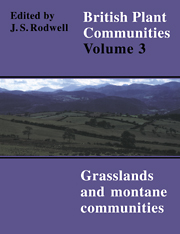Book contents
- Frontmatter
- Contents
- List of Figures
- Preface and Acknowledgements
- Preamble
- Mesotrophic Grasslands
- Community Descriptions
- Calcicolous Grasslands
- Community Descriptions
- Calcifugous Grasslands and Montane Communities
- Community Descriptions
- Index of Synonyms to Grasslands and Montane Communities
- Index of Species in Grasslands and Montane Communities
- Bibliography
Introduction to Mesotrophic Grasslands
Published online by Cambridge University Press: 04 July 2020
- Frontmatter
- Contents
- List of Figures
- Preface and Acknowledgements
- Preamble
- Mesotrophic Grasslands
- Community Descriptions
- Calcicolous Grasslands
- Community Descriptions
- Calcifugous Grasslands and Montane Communities
- Community Descriptions
- Index of Synonyms to Grasslands and Montane Communities
- Index of Species in Grasslands and Montane Communities
- Bibliography
Summary
The sampling of mesotrophic grasslands
Tansley (1911, 1939) understood ‘neutral grassland’ as comprising semi-natural swards dominated by grasses with associated dicotyledonous herbs but lacking any pronounced calcicole or calcifuge element. Such vegetation was found mostly on lowland clays and loams of acid to neutral reaction and was largely treated as agricultural land. Initially, Tansley (1911) envisaged a single broad association, the Graminetum neutrale, and though he later recognised some distinct meadow and pasture communities within this compass (Tansley 1939), it is clear that his ‘kernel of neutral grassland’, those species especially characteristic of these types of sward, is a somewhat partial and eccentric diagnosis. This is largely because his account was based on just a few stands of rather particular kinds of mesotrophic grassland which had been the subject of classic early studies: Lawes et al. (1882) on the Rothamsted grasslands, Fream (1888^/) on Hampshire water-meadows and Baker (1937) on the Oxford hay-meads and common pasture.
A renewed interest in these richer grassland types has developed with the urgent desire to conserve them in the face of widespread sward improvement for more productive agriculture. A greater range of communities has been recognised as a result of this concern, though these have often been defined by the occurrence of species of great conservation interest but of relatively little value in understanding more general ecological relationships among the full variety of British mesotrophic grasslands. Some unhelpfully broad categories, like ‘herbrich meadow’, have gained common currency, while certain widely distributed sward types, lacking rare or attractive plants, but equally part of our overall grassland economy, have consistently received short shrift (e.g. Duffey et al. 1974, Ratcliffe 1977).
The agricultural perspective on mesotrophic grasslands (e.g. Stapledon 1925, Fenton 1931, Davies 1941, 1952, Williams & Davies 1946) has been predominantly an economic one, interested in the abundance of a few widely distributed forage plants and aiming to provide a working basis for sward management and improvement. This kind of approach has tended to ignore associated species in its description of grassland types, even where these might help illuminate the condition or potential of the herbage, and to lump unproductive swards into very broad categories. In general, agriculturalists have been most interested in those mesotrophic grasslands which attract little attention from conservationists, and the latter most concerned for some (though not all) of those swards which farmers want simply to improve or ignore.
- Type
- Chapter
- Information
- British Plant Communities , pp. 17 - 25Publisher: Cambridge University PressPrint publication year: 1992



